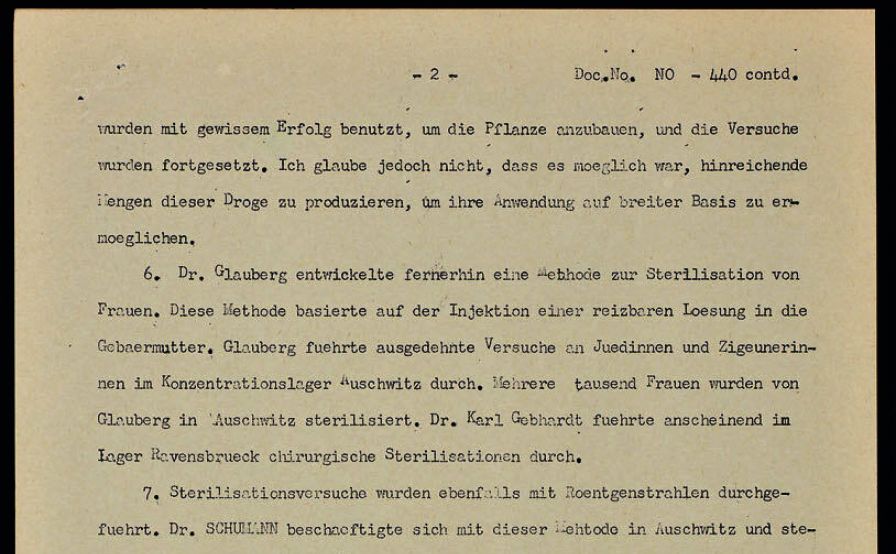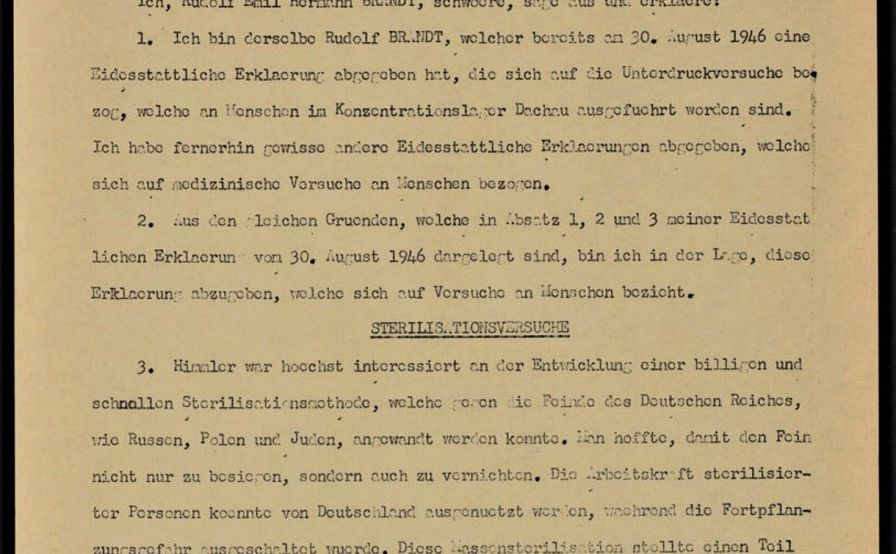Genocide: The Reich's Plan
One of the unexplored subjects in historiography is the mass sterilisation experiments, which took place under the patronage of Reichsführer-SS Heinrich Himmler between 1941 and 1945. Subject-specific studies that would cover the issue of drug-induced infertility in large human groups are unfortunately still lacking. As part of the documentary series “Genocide: The Reich's Plan” presented by the “Nuremberg. Casus Pacis” project, co-produced by the Eurasian Peoples' Assembly, and Egor Yakovlev, the research historian and Director of the Scientific and Educational Project “Digital History”, we publish documents that reveal attempts by the SS to create a miracle drug from the sap of a South American plant.
‘The Enemy Must Not Only Be Defeated But Exterminated’
Sterilisation experiments stand in sharp contrast with other SS medical projects which - whether developing a vaccine against malaria, a cure for frostbite or a way to convert seawater into drinking water - were aimed at rehabilitating the seriously wounded or enhancing the combat effectiveness of the armed forces. However, the search for a method that quickly and inconspicuously rendered masses of people incapable of procreation was by no means dictated by military objectives. The ultimate goal of the Nazis was to drastically reduce the unwanted population already in post-war Europe.
Specialists involved in such programmes were put on trial in the first of the Subsequent Nuremberg Trials – the so-called Doctors’ Trial – which was held from 9 December 1946 to 20 August 1947. Among those in the dock was Adolf Pokorny, a dermatologist who specialised in venereal diseases, whose memorandum led to the creation of a separate branch of SS research into mass sterilisation methods. Correspondence from Nazi officials, as well as the defendant’s detailed testimony, show what initiatives SS leaders were willing to support and what plans the boss had in mind.
In October 1941, Reichsführer-SS Himmler received a letter from Pokorny who at the time was a reserve medical officer and not part of the Third Reich's medical elite. He lived in a provincial Sudeten town and was completely unknown to Himmler. However, he was tireless in seeking contact with men of influence, and his efforts were successful. Pokorny drew the attention of the Reich's Chief of Racial Policy to the research of Gerhard Madaus, the founder of the Biological Institute in Radebeul-Dresden. This scientist's most recent articles examined the effects of the sap of the South American caladium plant (Caladium Seguinum) on animal reproduction.
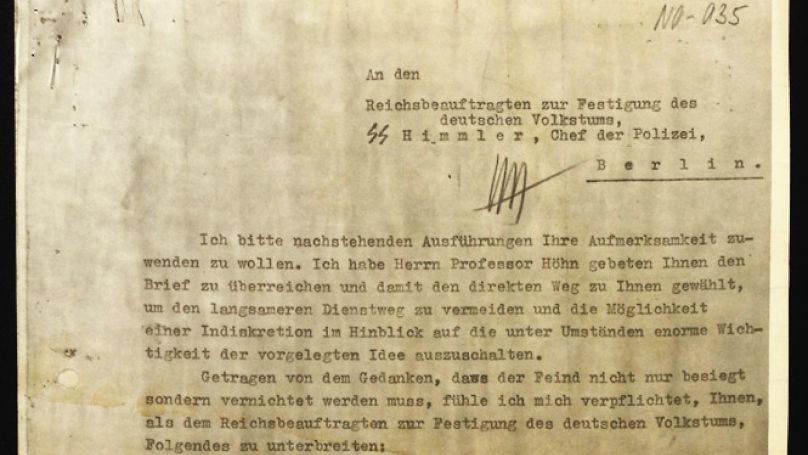
“Led by the idea that the enemy must not only be defeated but exterminated, I feel obliged to present to you, as the Reich Commissioner for the Consolidation of German Nation the following,” Pokorny wrote. “Dr Madaus published the result of his research on medical sterilisation. Reading these articles, the immense importance of this drug in the present fight of our people occurred to me. If, on the basis of this research, it were possible to produce a drug, which after a relatively short time, affects imperceptible sterilisation on human beings, then we would have a new powerful weapon at our disposal.
“The thought alone that the 3 million Bolsheviks - at the time German prisoners - could be sterilised so that they could be used as labourers but be preserved from reproduction, opens the most far-reaching perspectives.
“Madaus found that the sap of the caladium seguinum, when taken by mouth or given as an injection to male and female animals produces after a slight delay permanent sterility. The illustrations accompanying the scientific article are convincing.
“If my ideas meet with your approval, the following course should be taken:
“1) Dr Madaus must not publish any more such articles (the enemy listens!)
“2) Cultivation of the plant (easily done in greenhouses!)
“3) Immediate research on human beings (criminals!) to determine the dose and length of the treatment
“4) Quick research of the formula of the effective chemical substance in order to (...)
(...)
“5) ...produce it synthetically, if possible”.
Apparently, Himmler only managed to grasp the significance of the message by early March 1942. As Himmler admitted in his correspondence, the letter was of great interest to him. Although Pokorny was not even awarded a commendation, all his ideas were put into motion. On 10 March, Oswald Pohl, head of the SS Main Economic and Administrative Office, received an order to contact Madaus on behalf of the Reichsführer and persuade him to conduct experiments on humans in cooperation with the SS Reich Physician Ernst-Robert Grawitz. The experiments were to be carried out on criminals who were already subject to court-ordered sterilisation.
Poison or Radiation?
In Nazi Germany, compulsory sterilisation was used as a measure to improve the health of the nation. A law made in 1933 declared it compulsory for people with diseases such as congenital dementia, hereditary Huntington's chorea, epilepsy, cyclothymia and schizophrenia. This included particularly hardened alcoholics and dangerous criminals, and - from the late Thirties - opponents of the regime.
Apart from sterilisation as an instrument of political oppression, these were generally in line with global eugenic trends and were not specific to Germany. Similar measures were also in effect in a number of European countries and some US states.
However, in early 1941, the Nazis demanded that the Reich the practice to a whole new level. Under Himmler's management, the search began for a method of sterilisation which, first, would not affect an individual but large masses of people at once; secondly, would produce quick results; and thirdly, would be unnoticeable to those who had been sterilised. Obersturmbannführer-SS Rudolf Brandt, Personal Administrative Officer to Reichsführer-SS Himmler, outlined the goals of this research as follows:
“Himmler was extremely interested in the development of a cheap and rapid sterilisation method which could be used against enemies of Germany, such as Russians, Poles and Jews. The capacity for work of the sterilised persons could be exploited by Germany, while the danger of propagation would be eliminated.”
At first, radiation was considered the most promising method. Experiments to expose test subjects to radiation took place at Auschwitz under the supervision of SS-Oberführer Viktor Hermann Brack. However, the disadvantages of this method soon became evident: the radiation affected not only the sex glands, but inevitably other organs as well, leading to disability and often death of the victims. Consequently, they could no longer be used as slaves, which was considered wasteful. It is therefore not surprising that Himmler enthusiastically embraced Pokorny’s alternative.
A few months later, the SS chief requested a report from Pohl. On 3 June, the head of the SS Main Economic and Administrative Office reported that he was in touch with Dr Ernst Koch, Director of the Biological Institute and co-author with Madaus, but the research was stalled since “caladium seguinum grows only in North America (Pohl's mistake, actually in South America – ed. note Author) and during the war, could not be exported in adequate quantities.” Pohl further wrote that “attempts to grow the plant from seed cultivated in hothouses made by Dr Koch were successful, but the process of growing the plant and developing the drug is not speedy enough and the yield not sufficient to permit experimentation on a large scale.” A reply soon came from Rudolf Brandt, who assured Pohl that “a large hothouse will be placed at Koch’s disposal as soon as possible” as Himmler considered the experiments: “extremely important!”
To verify Madaus' experiments, the SS sent Karl Tauböck, an expert chemist from the biological laboratory of the IG Farben Group, to the Biological Institute in Dresden-Radebeul. He decided that although sterilisation with caladium seguinum was not ideal, it was within the bounds of possibility. On the return journey from Dresden to Berlin, the SS men revealed to him that this research was being carried out on the express order of Reichsführer-SS Himmler “in order to suppress birth among the eastern nations.”
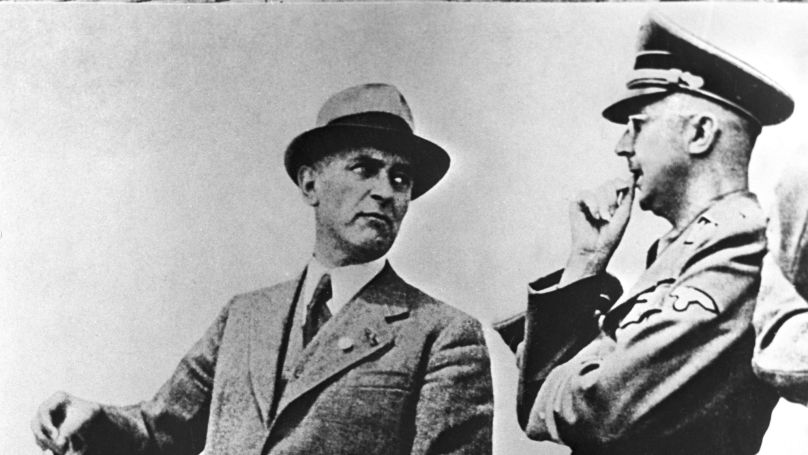
It is interesting to compare the revelations of the SS officers with the public statements of their chief. Thus, in the autumn of 1942, giving a speech at the SS-Junker School at Bad Tölz, the head of the "Black Order" revealed to the audience an epic plan to use the territories that would be seized from the USSR: “After the victory of the German Nation we still have to develop and colonise the eastern territory and incorporate it into the area of European culture. Within 20 years after the end of the war - a task which I have set for myself and hope to achieve together with you - the German border will be pushed 500km further to the East. We shall have to send our peasant families there, organise a migration of the best Germanic blood, and bind the many millions of Russian people to our ends. It means that when the bells across the world announce the greatest victory of our nation - the busiest time of our lives will begin. Twenty years of struggle for the conquest of the world are ahead... Then the East will be free of foreign blood and our families will settle there as landowners.” The sterilisation studies, including those initiated by Pokorny's letter, explain how Himmler expected to make the "foreign blood" in the East disappear a generation later.
It turned out in late August 1942 that Pokorny was not the only one to pay attention to Gerhardt Madaus's publications. A letter offering to use his method came to the Reichsführer's headquarters from SS Oberführer Karl Gerland, who served as Deputy Gauleiter in Reichsgau Lower Danube. He reported on the willingness of Dr Fehringer, head of the Regional Office for Racial Policy, to conduct studies on the effectiveness of caladium in Austria. Pohl's reply that such studies were already underway did not stop Gerland. He suggested to Brandt that he would still allow Fehringer to work with the major Austrian biologists to try to synthesise caladium sap in a laboratory setting. Furthermore, Fehringer was willing to cultivate the plant in greenhouses and test it on the inmates of the Lackenbach “Gypsy” Camp. Gerland requested the approval of his superiors to employ his staff together with Enno Lolling, head of the medical service at the concentration camps. Brandt replied that he had no doubts about the Himmler's agreement, and asked Pohl to establish this contact. This was how a second project group was formed which attempted to give the caladium effect so much wanted by Himmler.
However, neither Koch (Madaus died in 1942) nor Fehringer was able to achieve the desired result. Neither was it possible to synthesise an extract of the plant, nor harvest sufficient quantities of it. After 1942, Himmler no longer asked for reports on these works. His attention was once again consumed by experiments with radiation, this time under the direction of Doctor Horst Schumann, as well as research on the injection of acid into the womb, carried out at Auschwitz and later at Ravensbrück by the Physician Carl Clauberg.
A ‘Humble’ Doctor from Komotau
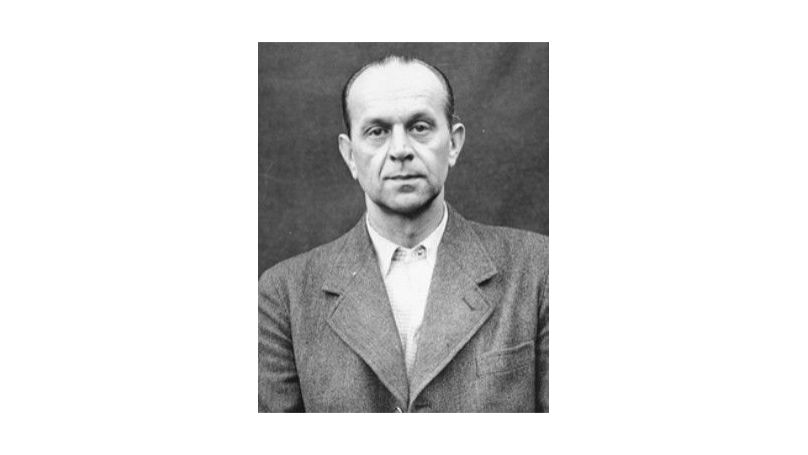
After the collapse of Nazism, when Pokorny's memorandum was found in the Reichsführer's papers, the author was arrested, although he had not taken part in any SS experiments during the war, had not bred caladium and had never even seen it. Pokorny was put on trial and that was how the public learnt the biography of the author of the sinister proposals, who was unexpectedly described by a number of witnesses as a man of democratic and anti-fascist views.
Adolf Pokorny was born in Vienna on 26 July 1895 as the son of a lieutenant-colonel in the Austro-Hungarian army of Czech origin. At the trial, the doctor claimed that since childhood he had experienced the peculiarities of soldier life with its constant moves – the exposure to different cultures allegedly developed a sense of tolerance in him. After graduating, the doctor married his Jewish colleague Lily Weil, and together they moved to Chomutov (Komotau), a small town in the Sudetenland, where the couple opened a private medical practice. They had a son and a daughter, and divorced in 1935.
After the German annexation of the Sudetenland, Pokorny's situation took a turn for the worse. The Nazi regime, following the anti-Semitic Nuremberg laws, tried to confiscate half of his house, which had belonged to the doctor's wife before the divorce. As the former husband of a Jewish woman and the father of two Jewish offspring (as Judaism is determined by the mother), whom his parents sent to England for safety in June, he himself was considered undesirable. For this reason, after the outbreak of the Second World War, Pokorny remained in the reserve and was not called up until January 1942. Shortly before being sent to the front, his ex-wife called him from Prague asking for help: she was threatened with a concentration camp. According to Pokorny's testimony, he wanted to go to see the mother of his children, but a Nazi officer came to him and told hum that his conversation with Lily Weil had been overheard. If he dared to go to the protectorate capital he would be shot in his own office. Pokorny soon left for the army, where he served until the end of the war. His former perished in the Holocaust.
What prompted this man to write the heinous letter to the Reichsführer-SS? Since it was pointless to deny authorship of the letter, Pokorny assured the court that through his actions he tried not to cause harm, but on the contrary, to save potential victims of Nazism. As stated in the indictment: “He claimed in his defence that he only wanted to prevent the execution of Himmler's intentions of mass sterilisation and extermination of the population of the eastern territories and the Jews... He considered the idea of the sterilisation by caladium unscientific and impossible of execution; that the conclusions of Madaus' articles did not quite correspond to the facts.” As such, Pokorny alleged that he decided to confuse Himmler to distract him from his intentions to use the truly effective and deadly radiation.
But how did Pokorny know about the radiation experiments given that they were not reported publicly in the German press? Allegedly a certain SS or SD officer named Voigt came to see him in mid-1941. Pokorny noted that the patient was not from Komotau, but a visitor from far away. Perhaps this was because of the delicate nature of the treatment: it was a venereal disease. Pokorny recalled that the officer had government medical insurance, but chose not to use it and asked to be treated privately.
During the check-up, Voigt happened to pick up a medical journal lying on the table and saw a recent article by Dr Madaus. He said that it would be right to bring this material to Himmler’s attention because the SS was looking for a way of mass sterilisation and were studying the possibilities of radiation. The officer also said that these experiments were directly linked to the war then in progress and the future settlement of the East. “He said that the German family had an average of two children, whereas the Slavic people had eight to 12 children. I had to conclude from the conversation that Himmler wanted to apply this mass sterilisation to various masses, especially the Slavs.” Voigt gave the impression of someone who was informed. In particular, he said that the command had already appointed a German police headquarters for Tiflis, which surprised Pokorny since the Wehrmacht troops were a long way from the capital of Soviet Georgia.
The defendant's testimony about the conversation with Voigt seems plausible. In any case, it is understandable why Pokorny expected Himmler to be interested in mass sterilisation material and why the Reichsführer would read the letter of the provincial doctor at all. But who might this mysterious Voigt be, so well-informed about SS and police plans in the East? This man's knowledge suggests that he was a high-ranking officer with links to those involved in operations in the occupied territories of the USSR.
Paul Schmitz-Voigt, a member of the NSDAP and the SS since 1933, who had been head of Munich's Criminal Police since March 1941, answers all these descriptions. This man had worked for two years in a similar post in Prague, just more than an hour's drive from Komotau. In his testimony, Pokorny mentioned that Voigt was not the only SS man who had used his services. Thus, the doctor might have been known among local SS officials as a good and sensitive specialist. Schmitz- Voigt might have heard of him while serving in the capital of the Protectorate of Bohemia and Moravia. A competent doctor in a small town in the newly annexed territories looks like an excellent option for secret treatment for an embarrassing illness.
Schmitz- Voigt was a member of the core staff of the RSHA and in one way or another knew the entire elite of the security services. For example, in 1937, he was deputy chief of the Prussian Criminal Police, where his immediate superior was Arthur Nebe, the future commander of Einsatzgruppe B in the East. With such connections, Schmitz-Feut could know, albeit unofficially, a great deal, including the facts of the radiation sterilisation experiments and the assignment of the police headquarters in the Caucasus. Of course, to assume that it was he who spoke to the author of the letter to Himmler needs to be confirmed but does not seem improbable.
In contrast with the story about Voigt, the defendant's explanation of his motivation certainly sounds dubious: Pokorny had a slim chance of "confusing" Himmler, since the Reichsführer-SS had major specialists at his disposal, outclassing Koporny in experience and know-how.
The notion that Pokorny had sent the memorandum to the SS chief to demonstrate loyalty to the regime and thereby secure his future appears much more realistic. At his trial, he admitted that he had been "inconvenienced" by political claims because of his years of being wed to a Jewish woman before 1940.
The tribunal considered the Komotau doctor's justification with scepticism but found no crime in his actions. The doctor was released and continued to practise medicine without any further questioning.

***
Although the Nazi projects to use caladium proved fruitless, the story of the Pokorny Memorandum is eminently eloquent. It proves that Heinrich Himmler did indeed consider it a priority of German medicine to find a quick and inconspicuous way of mass sterilisation. His inner circle was well aware of this, and some subordinates, such as Gerland and Fehringer, took part zealously.
This story demonstrates that the ultimate goals of the SS experiments were no particular secret. All sorts of Nazi functionaries, whether Voigt, Brandt or Tauböck, were aware of them. Pokorny himself, trying to justify that his letter referred to the sterilisation of "Bolshevik" prisoners, said: “I wrote what could make the most serious impression on Himmler”. In other words, he adapted to the addressee's request. Thus, it is impossible to disagree with the wording of the indictment of the Nuremberg Tribunal in the case of Hitler's doctors: “The Nazis sought the most scientific and least obvious methods of exterminating large human populations, both by direct killing and by depriving them of the ability to procreate. They were developing a new branch of medicine that would give them the scientific tools to plan and carry out genocide.”
Egor Yakovlev
Academic publication in History Journal, Volume 11, Issue 3 (89)
https://history.jes.su/s207987840009720-1-1/?sl=en

